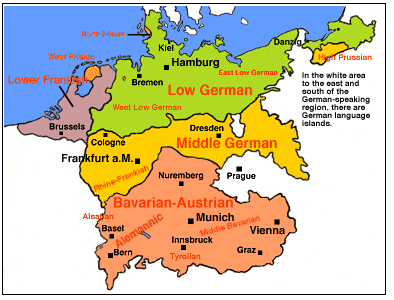ERIC KRAUSE
In
business since 1996
- © Krause House
Info-Research Solutions -
_____________________________________________________________________________________
BACKGROUND GENEALOGY
HIGH, LOW, MIDDLE GERMAN

http://german.about.com/library/graphics/dilktmap.gif
The Mennonites who later emigrated to the Russian spoke the low German language (Plautdietsch).
Niederdeutsch (Low German/Plattdeutsch)
Low German (also called Netherlandic or Plattdeutsch) gets its name from the geographic fact that the land is low (nether, nieder; flat, platt). It extends from the Dutch border eastward to the former German territories of Eastern Pommerania and East Prussia. It is divided into many variations including: Northern Lower Saxon, Westphalian, Eastphalian, Brandenburgian, East Pommeranian, Mecklenburgian, etc. This dialect often more closely resembles English (to which it is related) than standard German.
[Source: http://german.about.com/library/weekly/aa051898.htm ]
The Russian Mennonites that earlier came from the Vistula Delta spoke Plautdietsch a Mennonite variant of one of the many typical North Sea dialects called Niederdeutsch or Low German. Various dialects of Low German were, and are, in use from present day central Netherlands to northern Poland. The language was called “Low German” because the dialect was in use at or near sea level. High German (today's standard German) was in use in the southern mountains, particularly in Bavaria and therefore “high.” Similarly, Plautdietsch literally means “flat German,” again a reference to the lowland location of the Mennonites in the Vistula Delta.
In 1762, the first German sermon was preached in the Danzig Mennonite Church.
By 1777 the change from Dutch to German was almost complete. At this time the
Dutch
hymnbook was replaced by a German hymnal entitled: Geistreiches Gesangbuch,
worinn nebst denen 150 Psalmen Davids, eine Sammlung auserlesener alter und
neuer Lieder zu finden ist, zur allgemeinen Erbauung herausgegeben (Königsberg:
Daniel Christoph Kanter, 1767). ...
Until recently the Mennonite form of Low German was an unwritten language. It was the language of home, market, neighborhood gossip, and story telling. High German, especially because it was written, was the language of legal transactions, church, literature, education, and correspondence. For Mennonites High German written script was also an art form called Schönschreiben.
[Source: http://www.hillsboro-museums.com/Low-German.html ]